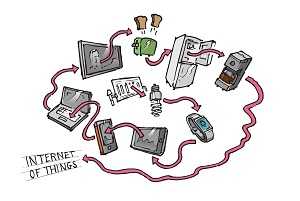Follow this checklist as everything from watches to thermostats goes online
 Tech-savvy higher education IT executives may be on top of many of the changes looming in technology, but the Internet of Things (IoT) is not yet one of them. They are fully aware it is coming, but as of now, the IoT is not yet a major focus. Given the wide-ranging security, bandwidth, legal and business implications involved, this may be a mistake.
Tech-savvy higher education IT executives may be on top of many of the changes looming in technology, but the Internet of Things (IoT) is not yet one of them. They are fully aware it is coming, but as of now, the IoT is not yet a major focus. Given the wide-ranging security, bandwidth, legal and business implications involved, this may be a mistake.
The Internet of Things basically refers to any so-called “smart” object that uses an internet connection to enhance functionality. Today there are watches, forks, thermostats, and any number of other related devices that students or school campuses may be bringing to a network near you.
Planning for this next evolution of networking needs to simultaneously be defensive (ensuring that IT infrastructure is ready) and offensive (encouraging and leading groups outside of the IT department such as teachers and students to take full advantage of the promise of the IoT.)
According to Gartner, we’ve entered the “Wild West” era in IoT adoption. With that in mind, here is a quick checklist for preparing your school or district.
Next page: Control the network and set your policy
The Network: Start with basic coverage and bandwidth capacity. IoT devices will be located throughout your buildings, including equipment mezzanines, maintenance rooms, even outdoor areas and parking lots. In the past, you probably concentrated your Wi-Fi coverage on locations where people work and congregate. Now you need to be sure there is coverage everywhere devices and other things may not only be bolted down, but slide, float, roll or fly to.
Your network security will need to be ready. Prepare the capacity of your Network Access Control to securely bring lots of new devices onto the network. You’ll need an easy means to monitor and track all the devices, and see which apps are accessing the devices and vice versa.
What types of networking will be required? Many IoT devices are controlled with Wi-Fi, but very low power devices may require a different sort of connection, such as Bluetooth, Bluetooth Low Energy (BLE), or near field communication (NFC). Make sure you have trouble-shooting capabilities ready to go for the network. Since something will be likely to go wrong with early implementations, you’ll need to be able to determine where the trouble is located. Network analytics are vital for this.
Servers: Although many IoT devices are operated from the cloud, you’ll need to understand the local data storage and processing demands they place on your servers. Is data cached or stored locally? What database management software will be required? Do you need a contingency plan capable of running locally if you become disconnected from the internet?
Displays and Dashboards: What devices will you need for displaying your IoT data? Smartphones have become the IoT remote control of convenience, if not default, but specialized displays are often required for commercial and process applications.
Custom Software: One of the reasons that the IoT has progressed so quickly is that so much of it runs without expensive customization. Often a standard Android or iOS smartphone sits at the center as the controller and display. New sites and apps like IFTTT have enabled custom configurations without traditional software development or coding. But don’t be surprised if some of your network users come to you with requests for tweaking, tuning, or outright software development. You’ll need to be prepared with a response. Getting to know all the key components in advance will help. API gateways, integration platforms as a service (iPaaS), and enterprise service buses (ESBs) enter the mix here. Ultimately all of your IoT projects will need to be tied into your corporate systems and databases, which may be far from automatic.
Policy: As with all Bring Your Own Device tools, you will need a clear policy regarding what is allowed on the network in terms of both devices and data. Provision needs to be made to prevent the network from becoming overwhelmed with streaming data and video. Just as some campuses restrict Wi-Fi access to gaming consoles and bandwidth-consuming apps like Netflix, special provisions or restrictions may be appropriate for streaming IoT devices.
People and Training: Within your IT department, you’ll want to prepare your staff as you would for any new technology deployment by making sure there is a solid understanding of the terminology, types of apps, and SLAs that will be required. Online training from companies and places such as Axelta, Experify (out of the Harvard Innovations Lab), and Tonex can also be a helpful resource for bringing people up to speed on the critical concepts of the Internet of Things.
If you have not yet begun to prepare your IT team for the Internet of Things, now is the time to get out in front of the oncoming Internet of Things train, before you miss your connection.
Bob Nilsson is director of solutions marketing at Extreme Networks. A version of this post recently appeared on its blog.
- TC- What student choice and agency actually looks like - November 15, 2016
- What student choice and agency actually looks like - November 14, 2016
- App of the Week: Science sensor meets your smartphone - November 14, 2016



Comments are closed.